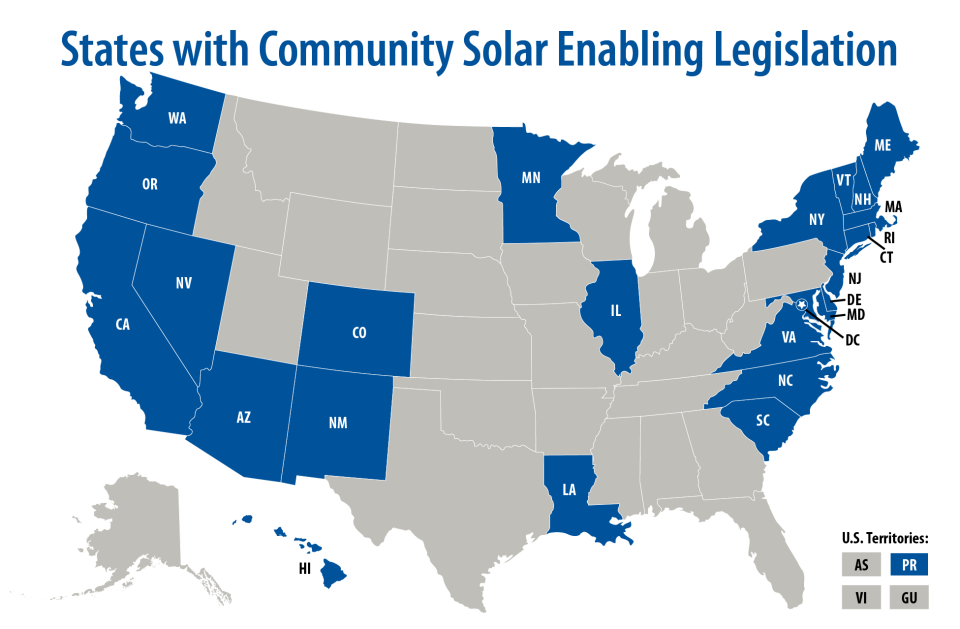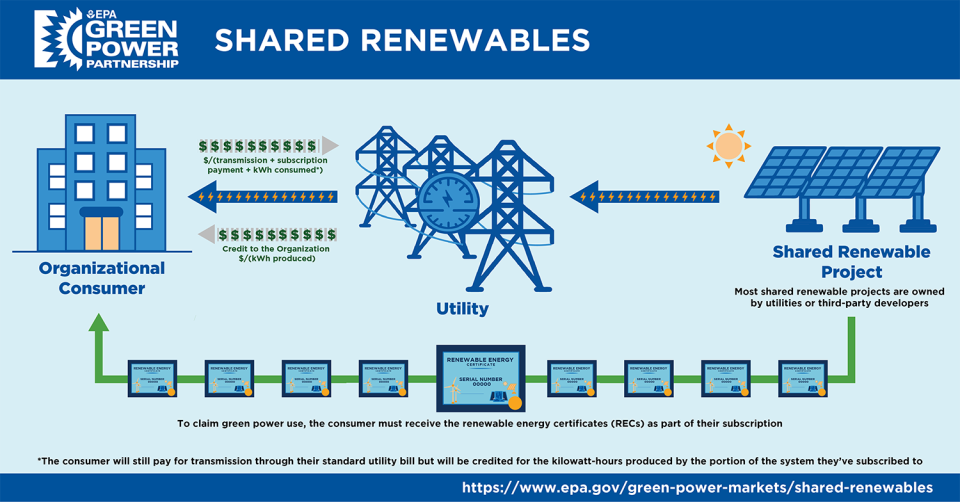Shared Renewables
Explore the sections below to learn more about shared renewables:
- What Are Shared Renewables?
- How Do Shared Renewables Work?
- Advantages and Challenges of Shared Renewables
- Additional Resources
What Are Shared Renewables?
Shared renewables, also known as community renewables, are an emerging procurement model allowing multiple customers to buy, lease, or subscribe to a portion of a shared green power system that is usually located away from their home or business. The model is especially appealing to customers whose on-site resource potential is limited; customers who rent; or customers who are otherwise unable or unwilling to install a renewable energy generator on their residences or commercial buildings.
Community solar, sometimes referred to as a “solar garden,” is currently the most popular form of shared renewables, with about 1,600 projects nationwide.1 According to a 2015 study by the National Renewable Energy Laboratory (NREL), over 50 percent of Americans who would like to use solar energy are unable to install a rooftop solar array.2 Shared renewable systems can enable those customers to purchase green power through an innovative supply option.
Shared renewables legislation—specifically, community solar legislation—has been enacted in 24 states (Arizona, California, Colorado, Connecticut, Delaware, Hawaii, Illinois, Louisiana, Massachusetts, Maryland, Maine, Minnesota, North Carolina, New Hampshire, New Jersey, New Mexico, Nevada, New York, Oregon, Rhode Island, South Carolina, Virginia, Vermont, and Washington), the District of Columbia and Puerto Rico.3
While Florida, Arkansas, Georgia, and Texas do not have specific legislation allowing community solar, States that voluntarily participate in community solar make up more than one-third of the total installed capacity by states, regardless of legislation status. The voluntary community solar market has boomed in recent years. For example, Florida has deployed 560 megawatts (MW) of projects since 2018.

How Do Shared Renewables Work?
In this procurement model, customers can choose to buy, lease, or subscribe to a portion of a shared renewable generator, which may be community-owned or owned by a third party.
With most shared renewable systems, the electricity is delivered to the grid. Customers receive credits on their utility electricity bill based on the amount of energy produced by their portion of the shared renewable system. This setup is called “virtual net metering.” In addition, the customer may receive the renewable energy certificates (RECs) generated by their portion of the shared renewable system, and they can substantiate green power use if that is the case.

However, some states preclude consumers from getting the RECs from these shared renewables and require the RECs to be sold to the utilities or load-serving entities.
Shared renewables can be structured in various ways, including:
- Utility-sponsored model — The utility owns and/or operates a shared renewables project that is open to voluntary ratepayer participation.
- Special purpose entity (SPE) model — Individual investors join in a business enterprise to form a new entity that develops a shared renewables project.
- Non-profit "buy a brick" model — Donors contribute to a shared renewables installation owned by a charitable non-profit corporation.
The below infographic depicts how typical Shared Renewables works.

Advantages and Challenges of Shared Renewables
Advantages:
- Available to customers who are not able to or do not want to host an on-site renewable energy system.
- Rapidly growing market means expanding opportunities to participate.
- Easy enrollment/cancellation with subscription model.
- Shared transaction costs often make this procurement option less expensive than self-supply.
- Economies of scale enable cost-effective construction of a renewable energy system at a site with optimal renewable resource availability.
- Customers are generally not responsible for maintenance and upkeep.
Challenges:
- Shared renewables programs commonly do not convey RECs to participants, which precludes participants from making any renewable energy use claims.
- Less visible commitment to renewables than onsite self-supply.
- Customers may not be able to make green power use claims.
- Enabling legislation is not available in all states.
Additional Resources
- NREL Community Solar
- NREL, 2021. Sharing the Sun: Community Solar Deployment, Subscription Savings, and Energy Burden Reduction (pdf)
- NREL, 2020. Community Solar 101 (pdf)
- NREL, 2015. Shared Solar: Current Landscape, Market Potential, and the Impact of Federal Securities Regulation (pdf)
- NREL, 2012, A Guide to Community Shared Solar (pdf)
- Shared Renewables. Community Energy Projects
- U.S. Department of Energy. National Community Solar Partnership
- Interstate Renewable Energy Council (IREC). Shared Renewables
- IREC. National Shared Renewables Scorecard
- Solar Energy Industries Association. Community Solar
1https://www.nrel.gov/docs/fy21osti/80246.pdf
2https://www.nrel.gov/docs/fy15osti/63892.pdf
3https://www.nrel.gov/state-local-tribal/community-solar.html
